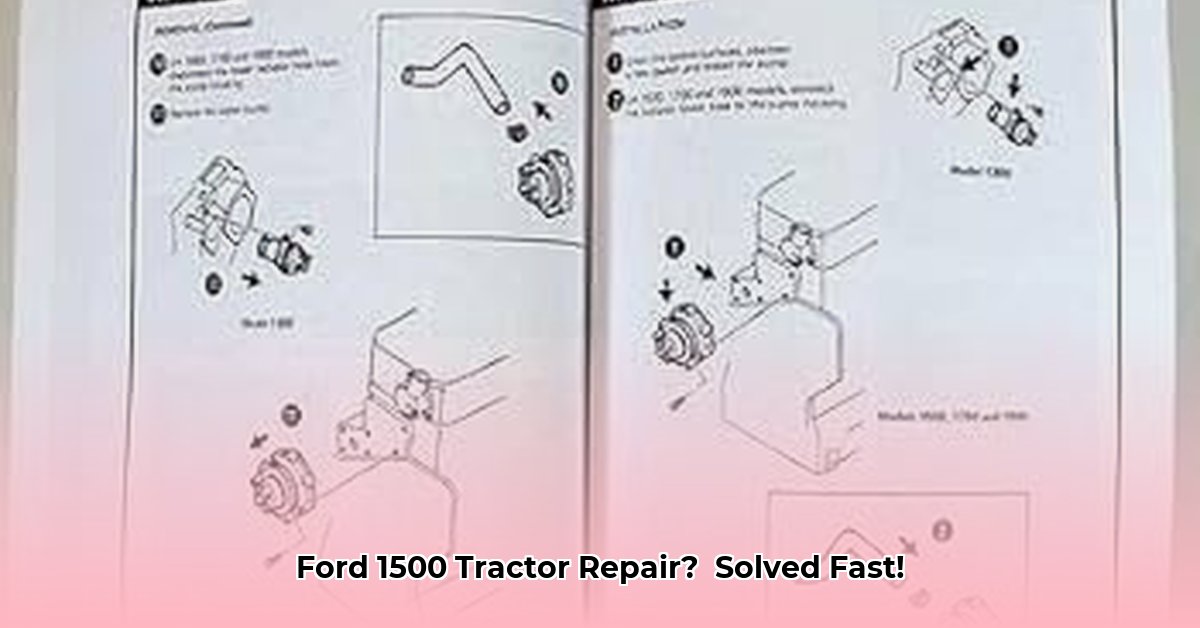
Understanding your Ford 1500 tractor's parts diagrams is crucial for efficient and cost-effective repairs. This guide provides a step-by-step approach to using these diagrams, even if you're not a seasoned mechanic. We'll demystify the process, guiding you from identifying the problem to ordering the correct replacement part. For additional wiring diagrams, check out this helpful resource: Ford Tractor Wiring.
Deciphering the Ford 1500 Parts Diagram: A Step-by-Step Guide
Your Ford 1500 tractor's parts diagram is essentially a detailed blueprint of your machine. Mastering it unlocks the ability to quickly diagnose and repair problems. But where do you even start? Let's break it down into manageable steps.
Identify the Problem Area: Before diving into the diagram, pinpoint the issue. Is your engine sputtering? Is the hydraulic system malfunctioning? Knowing the specific problem area will help you focus on the relevant section of the diagram. This initial assessment saves valuable time. Aren't you glad you're not starting blind?
Locate the Section: Ford 1500 tractor parts diagrams are typically organized into sections (engine, transmission, hydraulics, etc.). Find the section related to your identified problem. These diagrams are often visually segmented for ease of navigation. This process is similar to searching a well-organized library.
Find the Part Number: Within the relevant section, you'll find individual parts, each assigned a unique number or code. These numbers are your key to identifying and ordering the correct replacement part. Imagine these numbers as identifying markers in a treasure hunt.
Consult the Parts List: The parts diagram usually comes with a corresponding parts list. This list details each part's name, description, and order code (using the number from the diagram). This step links the visual representation with practical information.
Order the Replacement Part: Using the part number, you can now order the replacement part. Reputable online suppliers and your local Ford dealership are good sources. Remember to double-check the part number before ordering to ensure a precise match.
Installation and Testing: Once the replacement part arrives, carefully consult your owner's manual or a repair manual for installation instructions. After installation, thoroughly test your tractor to ensure everything is working correctly. This final step verifies the effectiveness of the whole process.
Pro Tips for Efficient Diagram Use
Mastering your Ford 1500's parts diagram will significantly improve the efficiency of your repairs. Here are some practical tips to make this process even smoother.
Ensure Clarity: A blurry diagram hinders efficiency. Make sure you have a clear, high-resolution version either printed or digitally displayed on a large screen.
Utilize Zoom Functions: Many parts within the diagram are small and detailed. Don't hesitate to use zoom functions to get a close-up view of specific components. Think of this as using a magnifying glass for better precision.
Check for Multiple Diagrams: Some systems might span multiple pages or sections within the diagram. Be sure to check all potentially relevant sections. Think of it as checking multiple maps for a complex location.
Understand the Symbols: Familiarize yourself with the symbols and notations used in the diagram. Understanding these conventions will expedite the process. These symbols are like a shorthand for complex components.
Seek Assistance When Needed: If you encounter a particularly challenging section, don't hesitate to seek help from a qualified mechanic or a knowledgeable member of an online Ford tractor community. Remember, there's no shame in asking for help.
Troubleshooting Common Diagram Challenges
Even with careful attention, challenges can arise. Here’s how to handle some common difficulties:
Outdated Diagrams: Parts diagrams might become out of date. Ensure you're using the latest version for your tractor's specific model and serial number. Always verify the version number to ensure accuracy.
Leverage Online Communities: Online forums and communities dedicated to Ford 1500 tractors can be invaluable resources. Others might have already encountered and solved a similar problem. Such forums are a great platform for learning from collective experience.
Seek Dealer Expertise: Your local Ford tractor dealership is a wealth of knowledge. They have access to the most up-to-date parts information and can often provide technical support. This is the go-to place for the most comprehensive assistance.
Beyond Parts Diagrams: Essential Repair Resources
While the parts diagram is vital, it is only part of the repair process. Utilizing these resources in conjunction with the diagram will ensure efficient and correct troubleshooting.
Owner's Manual: Your owner's manual contains general maintenance and operational information crucial for overall tractor understanding.
Repair Manuals: These offer detailed, step-by-step guidance for various repairs, providing contextual information beyond the parts diagram.
Reliable Online Resources: The internet offers a wealth of knowledge from experienced mechanics and fellow tractor owners. Always critically evaluate information found online.
Mastering your Ford 1500 tractor's parts diagram empowers you to perform repairs efficiently and cost-effectively. With practice and the guidance in this guide, you'll become confident in your ability to tackle future repairs. Remember, a well-understood parts diagram is the cornerstone of successful tractor maintenance.